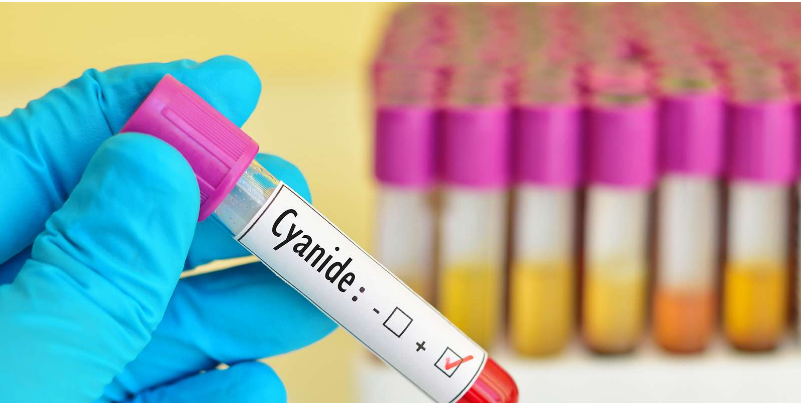博文
氰化物:我们细胞所必需的有毒气体
||
氰化物:我们细胞所必需的有毒气体
诸平
据瑞士弗里堡大学(University of Fribourg)2025年3月3日提供的消息,氰化物:我们细胞所必需的有毒气体(Cyanide: a toxic gas essential to our cells)。
毒药与非毒药的区别关键在于剂量。即使是毒药,在适量条件下它也可能会成为非毒药。来自瑞士弗里堡大学的一组科学家,描述了导致我们的细胞自然产生氰化氢的机制。这种气体,过量服用是有毒的,在我们身体的正常运作中起着重要作用。这一发现的治疗意义是相当可观的。
氰化氢被认为是有毒的,它不仅是哺乳动物细胞内源性和自然产生的气体,而且在哺乳动物细胞的正常功能中起着重要作用。如果没有萨巴·萨博教授(Professor Csaba Szabo)和他的国际团队的合作,这样一个令人信服的结论是不可能得到的。他们的研究结果于2025年3月3日已经在《自然代谢》(Nature Metabolism)杂志网站发表——Karim Zuhra, Maria Petrosino, Lucia Janickova, Jovan Petric, Kelly Ascenção, Thibaut Vignane, Moustafa Khalaf, Thilo M. Philipp, Stella Ravani, Abhishek Anand, Vanessa Martins, Sidneia Santos, Serkan Erdemir, Sait Malkondu, Barbara Sitek, Taha Kelestemur, Anna Kieronska-Rudek, Tomas Majtan, Luis Filgueira, Darko Maric, Stefan Chlopicki, David Hoogewijs, György Haskó, Andreas Papapetropoulos, Brian A. Logue, Gerry R. Boss, Milos R. Filipovic, Csaba Szabo. Regulation of mammalian cellular metabolism by endogenous cyanide production. Nature Metabolism, 2025. DOI: 10.1038/s42255-025-01225-w. Published: 03 March 2025. https://doi.org/10.1038/s42255-025-01225-w
参与此项研究的有来自瑞士弗里堡大学(Section of Pharmacology, Department of Oncology, Microbiology and Immunology, Faculty of Science and Medicine, University of Fribourg, Fribourg, Switzerland; Section of Anatomy, Department of Oncology, Microbiology and Immunology, Faculty of Science and Medicine, University of Fribourg, Fribourg, Switzerland; Department of Endocrinology, Metabolism and Cardiovascular System, Faculty of Science and Medicine, University of Fribourg, Fribourg, Switzerland)、德国莱布尼茨分析科学研究所(Leibniz Institute for Analytical Sciences, Dortmund, Germany)、美国南达科他州州立大学(Department of Chemistry and Biochemistry, South Dakota State University, Brookings, SD, USA)、希腊雅典学院生物医学研究基金会(Clinical, Experimental Surgery and Translational Research Center, Biomedical Research Foundation of the Academy of Athens, Athens, Greece)、土耳其塞尔库克大学(Selcuk University, Science Faculty, Department of Chemistry, Konya, Turkey)、土耳其吉瑞森大学Giresun University, Faculty of Engineering, Department of Environmental Engineering, Giresun, Turkey)、波兰雅吉隆大学(Jagiellonian Centre for Experimental Therapeutics, Jagiellonian University, Krakow, Poland)、美国哥伦比亚大学(Department of Anesthesiology, Columbia University, New York, NY, USA)、希腊雅典国立和卡波德斯德大学(Laboratory of Pharmacology, Department of Pharmacy, National and Kapodistrian University of Athens, Athens, Greece)、美国加州大学圣地亚哥分校(Department of Medicine, University of California, San Diego, San Diego, CA, USA)、英国格拉斯哥大学(School of Molecular Biosciences, University of Glasgow, Glasgow, UK)的研究人员。
在这篇文章中,科学家们首次揭示了这种气体产生背后的机制,以及当它变得过多或相反变得稀缺时对健康的影响。
一口氰化物(A lick of cyanide)
通过对人类细胞和活老鼠的实验,萨巴·萨博和他的同事们能够观察到氰化氢(HCN)系统地存在于体内。“我们能够证明这种气体是自然产生的,没有外部干预或污染,”萨巴·萨博解释说。这种现象在植物和细菌中已经为人所知,但尚未在哺乳动物中得到证实。
像任何一个有自尊的药理学家一样,萨巴·萨博开始着手确定是什么元素产生了这种氰化氢。
通过将甘氨酸(glycine)添加到细胞培养中,他和他的同事观察到氰化氢产量的增加:“我们已经证明了甘氨酸,一种存在于我们体内的氨基酸,会刺激某些细胞(如肝脏细胞)产生氰化氢。”
精确测量的重要性(The importance of accurate measurement)
对于研究小组来说,仍然需要了解身体如何调节这种物质的产生,以避免有毒物质的积累。
考虑到这一点,他们把注意力转向了硫氰酸酶(rhodanese),一种以氰化氢解毒而闻名的酶。
弗里堡大学的药理学家说:“与甘氨酸一样,几项体外和体内实验方法使我们能够证明硫氰酸酶是一种能够消除氰化氢的排雷剂。”这种酶将其转化为无毒的形式——硫氰酸盐(thiocyanate),保护细胞免受潜在的中毒。
治疗的影响(Therapeutic implications)
萨巴·萨博相信,发现和理解这些氰化氢产生和调节的机制可能具有重要的医学意义。这里有两个例子来说明这一点:
在实验室实验中,研究小组观察到,当存在少量氰化氢时,细胞在缺氧{oxygen deprivation (hypoxia)}中存活得更好。对于萨巴·萨博来说,这一发现可能有助于更好地治疗中风患者:在中风期间,脑细胞恰恰受到缺氧的影响。由于我们现在知道氰化氢可以保护细胞,因此不难想象它可以帮助减少中风造成的损害。
研究小组还发现,非酮症高血糖症(non-ketotic hyperglycemia简称NKH)等特定疾病会导致人体产生过多的氰化氢。在这种情况下,这种气体的积累会毒害细胞并扰乱它们的新陈代谢,对健康产生有害影响,甚至可能导致严重的神经紊乱。了解甘氨酸和硫氰酸酶的作用可能会导致治疗干预。
重大的发现(Major discoveries)
一群位于弗里堡的药理学家向著名的瑞士医生巴拉塞尔苏斯(Paracelsus)致敬,证实了一切都是毒药,没有什么是毒药:这永远是一个量的问题。这个有五个世纪历史的规则也适用于氰化物,它的毒性是众所周知的!
萨巴·萨博已经是众多科学出版物的作者,并且经常是世界上被引用最多的研究人员之一,尽管如此,他仍然认为这份出版物(上述研究论文)是他职业生涯中的一个真正的里程碑:“我确信这是我所做过的最伟大的发现之一,它将从根本上改变我们对细胞生物学和新陈代谢的看法。”
本研究得到了瑞士弗里堡大学(University of Fribourg ‘POOL de recherche’ grant)、瑞士国家研究基金会(Swiss National Research Foundation 310030L_204371 grant)、瑞士国家科学基金会(Swiss National Science Foundation Spark CRSK-3_221109 grant)、欧洲研究理事会(European Research Council grant 864921)以及希腊研究与创新基金会{Hellenic Foundation of Research and Innovation grant (‘Greece 2.0’ Project no. 15768)}的资助。
上述介绍仅供参考,欲了解更多信息敬请注意浏览原文和相关报道。
Small, gaseous molecules such as nitric oxide, carbon monoxide and hydrogen sulfide are produced as signalling molecules in mammalian cells. Here, we show that low concentrations of cyanide are generated endogenously in various mammalian tissues and cells. We detect cyanide in several cellular compartments of human cells and in various tissues and the blood of mice. Cyanide production is stimulated by glycine, occurs at the low pH of lysosomes and requires peroxidase activity. When generated at a specific rate, cyanide exerts stimulatory effects on mitochondrial bioenergetics, cell metabolism and cell proliferation, but impairs cellular bioenergetics at high concentrations. Cyanide can modify cysteine residues via protein S-cyanylation, which is detectable basally in cells and mice, and increases in response to glycine. Low-dose cyanide supplementation exhibits cytoprotective effects in hypoxia and reoxygenation models in vitro and in vivo. Conversely, pathologically elevated cyanide production in nonketotic hyperglycinaemia is detrimental to cells. Our findings indicate that cyanide should be considered part of the same group of endogenous mammalian regulatory gasotransmitters as nitric oxide, carbon monoxide and hydrogen sulfide.
https://blog.sciencenet.cn/blog-212210-1475784.html
上一篇:为何有人滴酒不沾,也会醉得不省人事?
下一篇:科学家发现工程细菌如何增强免疫系统以杀死癌症
2 王涛 郑永军
该博文允许注册用户评论 请点击登录 评论 (0 个评论)
1/0 | 闂傚倸鍊峰ù鍥敋閺嶎厼绀堟慨姗嗗劦閿濆绠虫俊銈咃攻閺咃綁姊虹捄銊ユ珢闁瑰嚖鎷�:0 | 濠电姷顣藉Σ鍛村磻閹捐泛绶ゅΔ锝呭暞閸嬪鏌eΟ娆惧殭鏉╂繈姊虹捄銊ユ珢闁瑰嚖鎷� | 濠电姷鏁搁崑鐐哄垂閸洖绠伴柟闂寸劍閺呮繈鏌ㄥ┑鍡樺窛闁告宀搁幃妤€鈽夊▍杈ㄧ矋缁傚秴饪伴崼鐔哄弳闂佺粯娲栭崐鍦偓姘炬嫹 | 闂傚倷娴囧畷鍨叏閹绢喖绠规い鎰堕檮閸嬵亪鏌涢妷顔句汗鐟滅増甯楅弲鎼佹煥閻曞倹瀚� |

